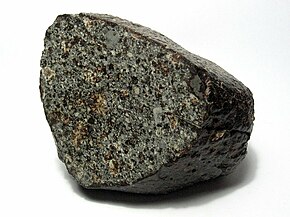
Back Chondriet Afrikaans كوندريت Arabic Хондрит Bulgarian Hondriti BS Condrita Catalan Chondrit Czech Chondrit German Χονδρίτης Greek Kondrito Esperanto Condrita Spanish
| Chondrite | |
|---|---|
| — Type — | |
 A specimen of the NWA 869 chondrite (type L4–6), showing chondrules and metal flakes | |
| Compositional type | Stony |
| Parent body | Small to medium asteroids that were never part of a body large enough to undergo melting and planetary differentiation. |
| Petrologic type | 3–6 |
| Total known specimens | Over 27,000 |
A chondrite /ˈkɒndraɪt/ is a stony (non-metallic) meteorite that has not been modified, by either melting or differentiation of the parent body.[a][1] They are formed when various types of dust and small grains in the early Solar System accreted to form primitive asteroids. Some such bodies that are captured in the planet's gravity well become the most common type of meteorite by (whether quickly, or after many orbits) arriving on a trajectory toward the planet's surface. Estimates for their contribution to the total meteorite population vary between 85.7%[2] and 86.2%.[3]
Their study provides important clues for understanding the origin and age of the Solar System, the synthesis of organic compounds, the origin of life and the presence of water on Earth. One of their characteristics is the presence of chondrules (from the Ancient Greek χόνδρος chondros, grain), which are round grains formed in space as molten or partially molten droplets of distinct minerals. Chondrules typically constitute between 20% and 80% of a chondrite by volume.[4]
Chondrites can be distinguished from iron meteorites by their low iron and nickel content. Non-metallic meteorites that lack chondrules are achondrites, which are believed to have formed more recently than chondrites.[5] There are currently over 27,000 chondrites in the world's collections. The largest individual stone ever recovered, weighing 1770 kg, was part of the Jilin meteorite shower of 1976. Chondrite falls range from single stones to extraordinary showers consisting of thousands of individual stones. An instance of the latter occurred in the Holbrook fall of 1912, in which an estimated 14,000 stones grounded in northern Arizona.
Cite error: There are <ref group=lower-alpha> tags or {{efn}} templates on this page, but the references will not show without a {{reflist|group=lower-alpha}} template or {{notelist}} template (see the help page).
- ^ "2.2 La composición de la Tierra: el modelo condrítico in Planetología. Universidad Complutense de Madrid". Archived from the original on 15 June 2009. Retrieved 19 May 2012.
- ^ Calvin J. Hamilton (Translated from English by Antonio Bello). "Meteoroides y Meteoritos" (in Spanish). Archived from the original on 25 February 2021. Retrieved 18 April 2009.
- ^ Bischoff, A.; Geiger, T. (1995). "Meteorites for the Sahara: Find locations, shock classification, degree of weathering and pairing". Meteoritics. 30 (1): 113–122. Bibcode:1995Metic..30..113B. doi:10.1111/j.1945-5100.1995.tb01219.x. ISSN 0026-1114.
- ^ Axxón. "Pistas químicas apuntan a un origen de polvo para los planetas terrestres" (in Spanish). Archived from the original on 3 August 2008. Retrieved 11 May 2009.
- ^ Jordi, Llorca Pique (2004). "Nuestra historia en los meteoritos". El sistema solar: Nuestro pequeño rincón en la vía láctea. Universitat Jaume I. p. 75. ISBN 978-8480214667. Archived from the original on 13 January 2023. Retrieved 30 October 2020.
© MMXXIII Rich X Search. We shall prevail. All rights reserved. Rich X Search